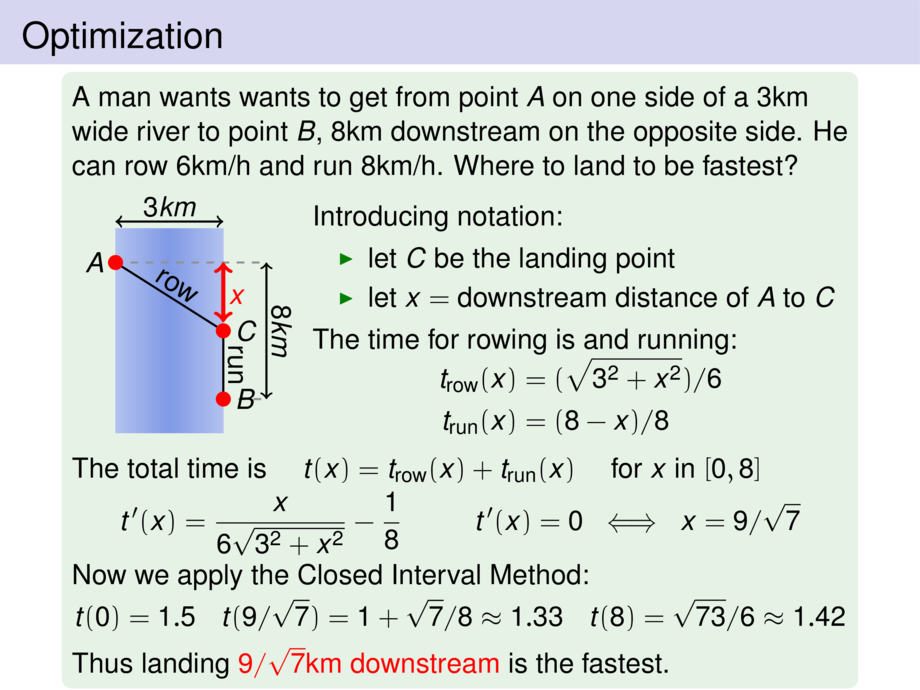



































































































126/171
\begin{frame}
\frametitle{Optimization}
\vspace{-1ex}
\begin{exampleblock}{}
A man wants wants to get from point $A$ on one side of a $3$km wide river
to point $B$, $8$km downstream on the opposite side.
He can row $6$km/h and run $8$km/h. Where to land to be fastest?
\pause\medskip
\begin{minipage}{.3\textwidth}
\begin{center}
\begin{tikzpicture}[default,yscale=.95]
\draw[draw=none,shade,left color=cblue!30,right color=cblue!50] (0,0) rectangle (.75,3);
\draw[draw=none,shade,right color=cblue!30,left color=cblue!50] (.74,0) rectangle (1.5,3);
\mpause[1]{
\draw (0,2.5) -- node[above,sloped] {row} (1.5,1.5) -- node[above,sloped] {run} (1.5,.5);
}
\mpause{
\draw[<->] (0,3.1) -- node[above] {$3km$} (1.5,3.1);
}
\mpause{
\draw[<->] (2.1,2.5) -- node[above,sloped] {$8km$} (2.1,.5);
\draw[gray,dashed] (0,2.5) -- (2.1,2.5);
\draw[gray,dashed] (1.5,.5) -- (2.1,0.5);
}
\mpause{}
\mpause{
\node[include=cred] (c) at (1.5,1.5) {};
\node[anchor=west,xshift=1mm] at (c) {$C$};
}
\mpause{
\draw[ultra thick,cred,<->,shorten <= 0mm, shorten >= 1.2mm] (1.5,2.5) -- node[right] {$x$} (1.5,1.5);
}
\node[include=cred] (a) at (0,2.5) {};
\node[anchor=east,xshift=-1mm] at (a) {$A$};
\node[include=cred] (b) at (1.5,.5) {};
\node[anchor=west,xshift=1mm] at (b) {$B$};
\end{tikzpicture}
\end{center}
\end{minipage}~%
\begin{minipage}{.69\textwidth}
\pause\pause\pause
\mpause[1]{
Introducing notation:
\begin{itemize}
\pause\pause
\item let $C$ be the landing point
\pause
\item let $x = $ downstream distance of $A$ to $C$
\end{itemize}
\pause
The time for rowing is and running:\vspace{-1ex}
\begin{talign}
t_{\text{row}}(x) &= \mpause[1]{(\sqrt{3^2 + x^2})/6} \\
\mpause{t_{\text{run}}(x) &=} \mpause{(8-x)/8}
\end{talign}\vspace{-4ex}
\pause\pause
}
\end{minipage}
\pause\smallskip
\mpause[1]{
\pause
The total time is
\quad $t(x) = t_{\text{row}}(x) + t_{\text{run}}(x)$ \quad for $x$ in $[\mpause[1]{0},\mpause[1]{8}]$
}
\pause\pause\vspace{-.7ex}
\begin{talign}
t'(x) &= \mpause[1]{\frac{x}{6\sqrt{3^2 + x^2}} - \frac{1}{8}}
\hspace{1cm} \mpause[8]{t'(x) = 0 \;\iff\; x = 9/\sqrt{7} }
\only<-23>{
\\
\mpause[2]{t'(x) &= 0 \;\iff\;}
\mpause{3\sqrt{3^2 + x^2} = 4x}
\mpause{\;\stackrel{x\ge 0}{\iff}\; 9(3^2 + x^2) = 16x^2}\\[-.5ex]
\mpause{&\;\iff\; 7x^2 = 81}
\mpause{\;\iff\; x^2 = 81/7}
\mpause{\;\stackrel{x\ge 0}{\iff}\; x = 9/\sqrt{7}}
}
\end{talign}
\pause[25]\vspace{-2ex}%
Now we apply the \pause Closed Interval Method:\vspace{-.5ex}\pause
\begin{talign}
t(0) &= \mpause[1]{1.5} &
t(9/\sqrt{7}) &= \mpause[2]{1 + \sqrt{7}/8 \approx 1.33} &
t(8) &= \mpause[3]{\sqrt{73}/6 \approx 1.42}
\end{talign}\vspace{-2.5ex}
\pause\pause\pause\pause
Thus landing \alert{\mpause[1]{$9/\sqrt{7}$}km downstream} is the fastest.
\end{exampleblock}
\vspace{10cm}
\end{frame}

